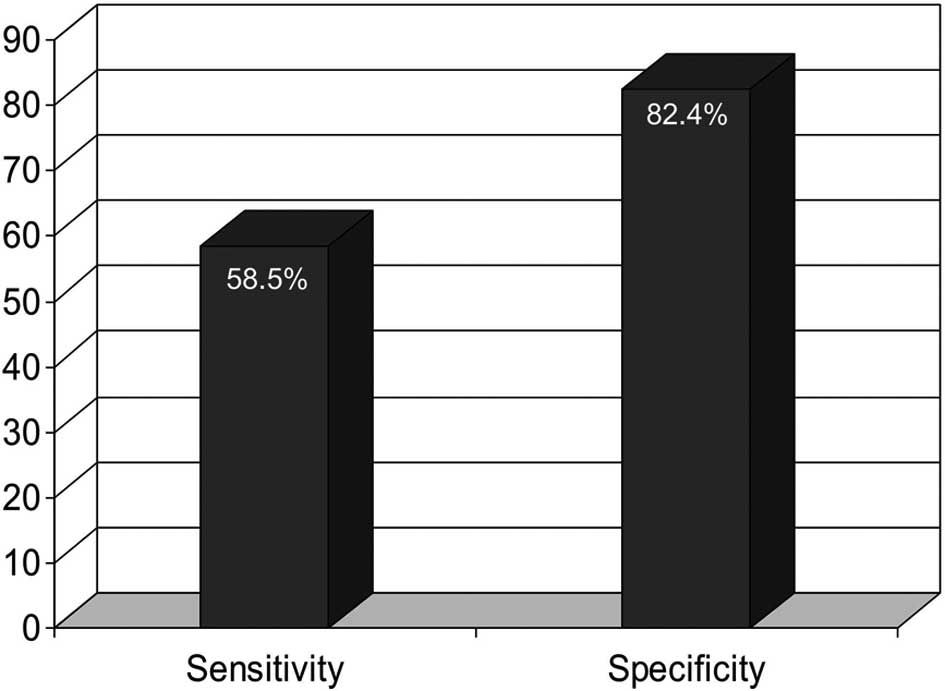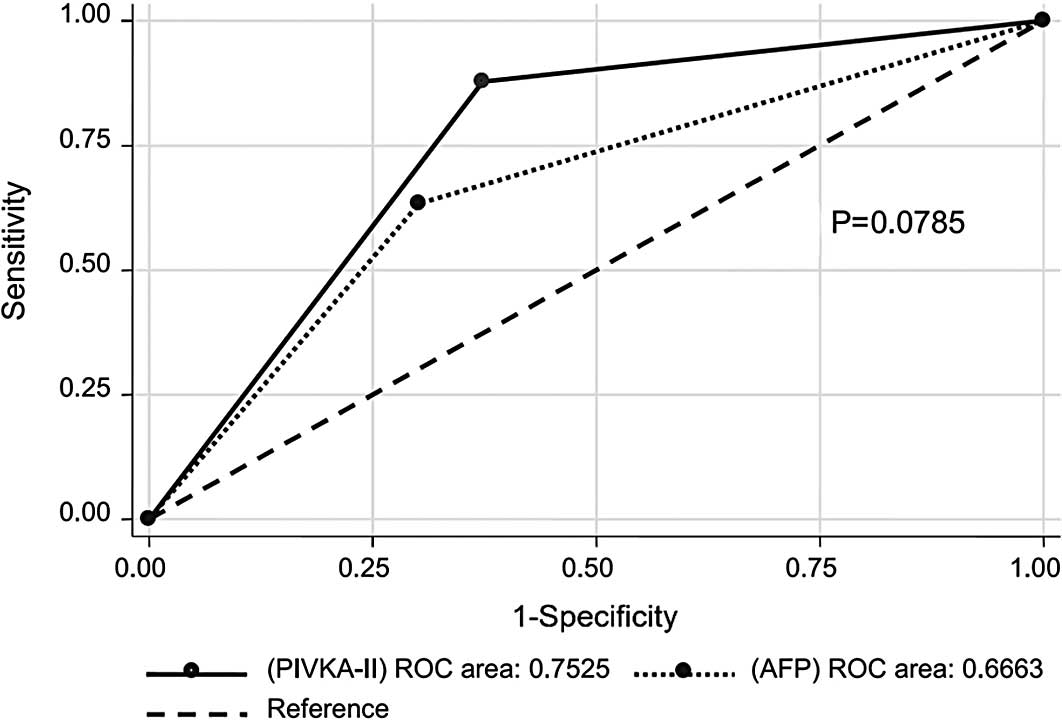|
1.
|
Truong BX and Bang NV: The prevalence of
HBV infection, HCV infection, co-infection of HBV/HCV and HBV
genotype in the border region between Vietnam and China in Batxat
district, Laocai province. Vietnam J Med Res. 64:52–59. 2009.
|
|
2.
|
Duong TH, Nguyen PH, Henley K and Peters
M: Risk factors for hepatitis B infection in rural Vietnam. Asian
Pac J Cancer Prev. 10:97–102. 2009.PubMed/NCBI
|
|
3.
|
Nguyen VT, McLaws ML and Dore GJ: Highly
endemic hepatitis B infection in rural Vietnam. J Gastroenterol
Hepatol. 22:2093–2100. 2007. View Article : Google Scholar : PubMed/NCBI
|
|
4.
|
Hipgrave DB, Nguyen TV, Vu MH, Hoang TL,
Do TD, Tran NT, Jolley D, Maynard JE and Biggs BA: Hepatitis B
infection in rural Vietnam and the implications for a national
program of infant immunization. Am J Trop Med Hyg. 69:288–294.
2003.PubMed/NCBI
|
|
5.
|
Truong BX, Yano Y, Seo Y, et al:
Variations in the core promoter/pre-core region in HBV genotype C
in Japanese and Northern Vietnamese patients. J Med Virol.
79:1293–1304. 2007. View Article : Google Scholar : PubMed/NCBI
|
|
6.
|
Truong BX, Seo Y, Yano Y, et al: Genotype
and variations in core promoter and pre-core regions are related to
progression of disease in HBV-infected patients from Northern
Vietnam. Int J Mol Med. 19:293–299. 2007.PubMed/NCBI
|
|
7.
|
Huy TT, Ushijima H, Quang VX, Ngoc TT,
Hayashi S, Sata T and Abe K: Characteristics of core promoter and
precore stop codon mutants of hepatitis B virus in Vietnam. J Med
Virol. 74:228–236. 2004. View Article : Google Scholar : PubMed/NCBI
|
|
8.
|
Truong BX, Yano Y, Seo Y, et al: T1653
mutation (C to T1653) in the box-alpha of X gene in relation to
genotype, HBV-DNA level and HBeAg status in HBV-infected Vietnamese
patiens. Vietnam J Med Res. 45:26–31. 2006.
|
|
9.
|
Vuong DA, Velasco-Garrido M, Lai TD and
Busse R: Temporal trends of cancer incidence in Vietnam, 1993–2007.
Asian Pac J Cancer Prev. 11:739–745. 2010.PubMed/NCBI
|
|
10.
|
Anh PT and Duc NB: The situation with
cancer control in Vietnam. Jpn J Clin Oncol. 32(Suppl): S92–S97.
2002. View Article : Google Scholar : PubMed/NCBI
|
|
11.
|
Ferlay J, Shin HR, Bray F, Forman D,
Mathers C and Parkin DM: Estimates of world burden cancer in 2008:
GLOBOCAN 2008. Int J Cancer. 127:2893–2917. 2010. View Article : Google Scholar : PubMed/NCBI
|
|
12.
|
Sheu JC, Sung JL, Chen DS, et al: Early
detection of hepatocellular carcinoma by real-time ultrasonography.
A prospective study. Cancer. 56:660–666. 1985. View Article : Google Scholar : PubMed/NCBI
|
|
13.
|
Oka H, Tamori A, Kuroki T, Kobayashi K and
Yamamoto S: Prospective study of alpha-fetoprotein in cirrhotic
patients monitored for development of hepatocellular carcinoma.
Hepatology. 19:61–66. 1994. View Article : Google Scholar : PubMed/NCBI
|
|
14.
|
Di Bisceglie AM and Hoofnagle JH:
Elevation in serum alphafetoprotein levels in patients with chronic
hepatitis B. Cancer. 64:2117–2120. 1989.
|
|
15.
|
Bruix J, Sherman M, Llovet JM, et al:
Clinical management of hepatocellular carcinoma. Conclusion of the
Barcelona-2000 EASL conference. European Association for the Study
of the liver. J Hepatol. 35:421–430. 2001. View Article : Google Scholar : PubMed/NCBI
|
|
16.
|
Sherman M: Surveillance for hepatocellular
carcinoma. Semin Oncol. 28:450–459. 2001. View Article : Google Scholar : PubMed/NCBI
|
|
17.
|
Gupta S, Bent S and Kohlwes J: Test
characteristics of alpha-fetoprotein for detecting hepatocellular
carcinoma in patients with hepatitis C. A systemic review and
critical analysis. Ann Intern Med. 139:46–50. 2003. View Article : Google Scholar : PubMed/NCBI
|
|
18.
|
Marrero JA and Lok AS: Newer markers for
hepatocellular carcinoma. Gastroenterology. 127(5 Suppl 1):
S113–S119. 2004. View Article : Google Scholar : PubMed/NCBI
|
|
19.
|
Khien VV, Mao HV, Chinh TT, Ha PT, Bang
MH, Lac BV, Hop TV, Tuan NA, Don LV, Taketa K and Satomura S:
Clinical evaluation of lectin-reactive alpha-fetoprotein-L3 in
histology-proven hepatocellular carcinoma. Int J Biol Markers.
16:105–111. 2001.
|
|
20.
|
Liebman HA, Furie BC, Tong MJ, Blanchard
RA, Lo KJ, Lee SD, Coleman MS and Furie B: Des-gamma-carboxy
(abnormal) prothrombin as a serum marker of primary hepatocellular
carcinoma. N Eng J Med. 310:1427–1431. 1984. View Article : Google Scholar : PubMed/NCBI
|
|
21.
|
Cui R, He J, Zhang F, Wang B, Ding H, Shen
H, Li Y and Chen X: Diagnostic value of protein induced by vitamin
K absence (PIVKA-II) and hepatoma-specific band of serum
gamma-glutamyl transferase (GGTII) as hepatocellular carcinoma
marker complementary to alpha-fetoprotein. Br J Cancer.
88:1878–1882. 2003. View Article : Google Scholar
|
|
22.
|
Nagaoka S, Yatsuhashi H, Hamada H, Yano K,
Matsumoto T, Daikoku M, Arisawa K, Ishibashi H, Koga M, Sata M and
Yano M: The des-gamma carboxy prothrombin index is a new prognostic
indicator for hepatocellular carcinoma. Cancer. 98:2671–2677. 1993.
View Article : Google Scholar : PubMed/NCBI
|
|
23.
|
Nakamura S, Nouso K, Sakaguchi K, Ito YM,
Ohashi Y, Kobayashi Y, Toshikuni N, Tanaka H, Miyake Y, Matsumoto E
and Shiratori Y: Sensitivity and specificity of des-gamma-carboxy
prothrombin for diagnosis of patients with hepatocellular
carcinomas varies according to tumor size. Am J Gastroenterol.
101:2038–2043. 2006. View Article : Google Scholar : PubMed/NCBI
|
|
24.
|
Marrero JA, Feng Z, Wang Y, et al:
Alpha-fetoprotein, des-gamma-carboxy prothrombin, and lectin-bound
alpha-fetoprotein in early hepatocellular carcinoma.
Gastroenterology. 137:110–118. 2009. View Article : Google Scholar : PubMed/NCBI
|
|
25.
|
Lok AS, Sterling RK, Everhart JE, Wright
EC, Hoefs JC, Di Bisceglie AM, Morgan TR, Kim HY, Lee WM, Bonkovsky
HL and Dienstag JL; HALT-C Trial Group: Des-gamma-carboxy
prothrombin and alpha-fetoprotein as biomarkers for the early
detection of hepatocellular carcinoma. Gastroenterology.
138:439–502. 2010.PubMed/NCBI
|
|
26.
|
Miyaaki H, Nakashima O, Kurogi M, Eguchi K
and Kojiro M: Lens culinaris agglutinin-reactive alpha-fetoprotein
and protein induced by vitamin K absence II are potential
indicators of a poor prognosis: a histopathological study of
surgically resected hepatocellular carcinoma. J Gastroenterol.
42:962–968. 2007. View Article : Google Scholar
|
|
27.
|
Shirabe K, Itoh S, Yoshizumi T, Soejima Y,
Taketomi A, Aishima S and Maehara Y: The predictors of
microvascular invasion in candidates for liver transplantation with
hepatocellular carcinoma-with special reference of the serum levels
of des-gamma-carboxy prohrombin. J Surg Oncol. 95:235–240. 2007.
View Article : Google Scholar : PubMed/NCBI
|
|
28.
|
Wang CS, Lin CL, Lee HC, Chen KY, Chiang
MF, Chen HS, Lin TJ and Liao LY: Usefulness of serum
des-gamma-carboxy prothrombin in detection of hepatocellular
carcinoma. World J Gastroenterol. 11:6115–6119. 2005.PubMed/NCBI
|
|
29.
|
Marrero JA, Su GL, Wei W, Emick D,
Conjeevaram HS, Fontana RJ and Lok AS: Des-gamma carboxyprothrombin
can differentiate hepatocellular carcinoma from nonmalignant
chronic liver disease in American patients. Hepatology.
37:1114–1121. 2003. View Article : Google Scholar : PubMed/NCBI
|
|
30.
|
Koike Y, Shiratori Y, Sato S, Obi S,
Teratani T, Imamura M, Yoshida H, Shiina S and Omata M:
Des-gamma-carboxy prothrombin as a useful predisposing factor for
the development of portal venous invasion in patients with
hepatocellular carcinoma: a prospective analysis of 227 patients.
Cancer. 91:561–569. 2001. View Article : Google Scholar
|
|
31.
|
Sharma B, Srinivasan R, Chawla YK, Kapil
S, Saini N, Singla B, Chakraborthy A, Kalra N, Duseja A and Dhiman
RK: Clinical utility of prothrombin induced by vitamin K absence in
the detection of hepatocellular carcinoma in Indian population.
Hepatol Int. 4:569–576. 2010. View Article : Google Scholar : PubMed/NCBI
|
|
32.
|
Abe A, Inoue K, Tanaka T, Kato J, Kajiyama
N, Kawaguchi R, Tanaka S, Yoshiba M and Kohara M: Quantitation of
hepatitis B virus genomic DNA by real time detection PCR. J Clin
Microbiol. 37:2899–2903. 1999.PubMed/NCBI
|
|
33.
|
Mizokami M, Nakano T, Orito E, Tanaka Y,
Sakugawa H, Mukaide M and Robertson BH: Hepatitis B virus genotype
assignment using restriction fragment length polymorphism pattern.
FEBS Lett. 450:66–71. 1999. View Article : Google Scholar : PubMed/NCBI
|
|
34.
|
Sato T, Tateishi R, Yoshida H, et al:
Ultrasound surveillance for early detection of hepatocellular
carcinoma among patients with hepatitis C. Hepatol Int. 3:544–550.
2009. View Article : Google Scholar : PubMed/NCBI
|
|
35.
|
Forner A, Vilana R, Ayuso C, et al:
Diagnosis of hepatic nodules 20 mm or smaller in cirrhosis:
prospective validation of the noninvasive diagnostic criteria for
hepatocellular carcinoma. Hepatology. 47:97–104. 2008. View Article : Google Scholar
|
|
36.
|
Nguyen MH, Garcia RT, Simpson PW, Wright
TL and Keeffe EB: Racial differences in effectiveness of
alpha-fetoprotein for diagnosis of hepatocellular carcinoma in
hepatitis C virus cirrhosis. Hepatology. 36:410–417. 2002.
View Article : Google Scholar : PubMed/NCBI
|
|
37.
|
Takano S, Honda I, Watanabe S, Soda H,
Nagata M, Hoshino I, Takenouchi T and Miyazaki M:
PIVKA-II-producing advanced gastric cancer. Int J Clin Oncol.
9:330–333. 2004. View Article : Google Scholar : PubMed/NCBI
|
|
38.
|
Takahashi Y, Inoue T and Fukusato T:
Protein induced by vitamin K absence or antagonist-II-producing
gastric cancer. World J Gastrointest Pathophysiol. 1:129–136. 2010.
View Article : Google Scholar : PubMed/NCBI
|
|
39.
|
Durazo FA, Blatt LM, Corey WG, Lin JH, Han
S, Saab S, Busuttil RW and Tong MJ: Des-gamma-carboxy prothrombin,
alpha-fetoprotein and AFP-L3 in patients with chronic hepatitis,
cirrhosis and hepatocellular carcinoma. J Gastroenterol Hepatol.
23:1541–1548. 2008. View Article : Google Scholar
|
|
40.
|
Iwatsuki S, Dvorchik I, Marsh JW,
Madariaga JR, Carr B, Fung JJ and Starzl TE: Liver transplantation
for hepatocellular carcinoma: a proposal of a prognostic scoring
system. J Am Coll Surg. 191:389–394. 2000. View Article : Google Scholar : PubMed/NCBI
|
|
41.
|
Hemming AW, Cattral MS, Reed AI, Van Der
Werf WJ, Greig PD and Howard RJ: Liver transplantation for
hepatocellular carcinoma. Ann Surg. 233:652–659. 2001. View Article : Google Scholar : PubMed/NCBI
|
|
42.
|
Mazzaferro V, Regalia E, Doci R, Andreola
S, Pulvirenti A, Bozzetti F, Montalto F, Ammatuna M, Morabito A and
Gennari L: Liver transplantation for the treatment of small
hepatocellular carcinomas in patients with cirrhosis. N Engl J Med.
334:693–699. 1996. View Article : Google Scholar : PubMed/NCBI
|
|
43.
|
Mazzaferro V, Chun YS, Poon RT, Schwartz
ME, Yao FY, Marsh JW, Bhoori S and Lee SG: Liver transplantation
for hepatocellular carcinoma. Ann Surg Oncol. 15:1001–1007. 2008.
View Article : Google Scholar : PubMed/NCBI
|
|
44.
|
Yao FY, Ferrell L, Bass NM, Bacchetti P,
Ascher NL and Roberts JP: Liver transplantation for hepatocellular
carcinoma: comparison of the proposed UCSF criteria with the Milan
criteria and the Pittsburgh modified TNM criteria. Liver Transpl.
8:765–774. 2002. View Article : Google Scholar : PubMed/NCBI
|
|
45.
|
Yao FY: Liver transplantation for
hepatocellular carcinoma: beyond the Milan criteria. Am J
Transplant. 8:1982–1989. 2008. View Article : Google Scholar : PubMed/NCBI
|
















